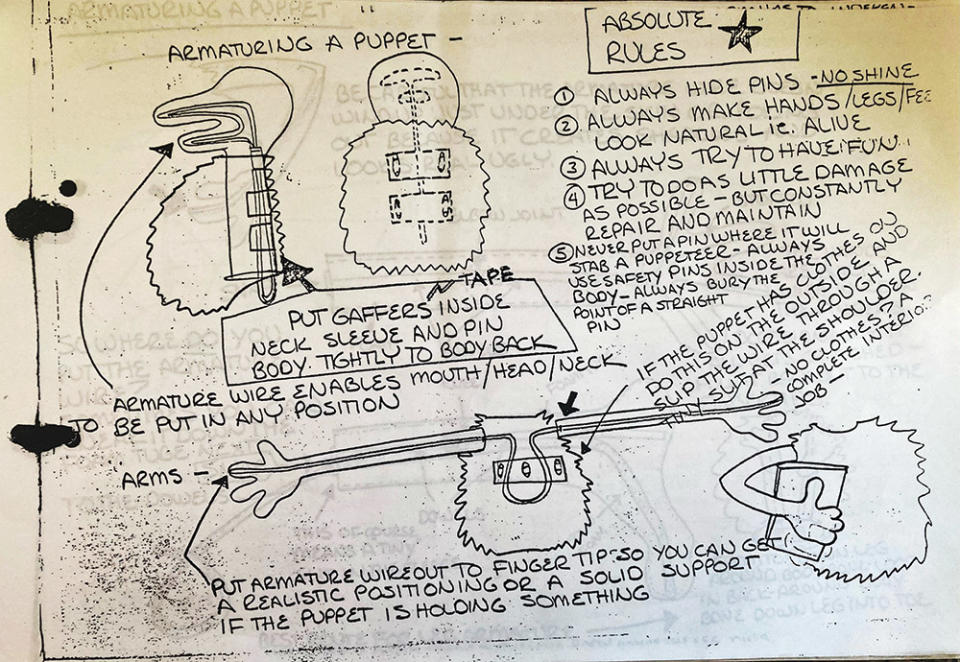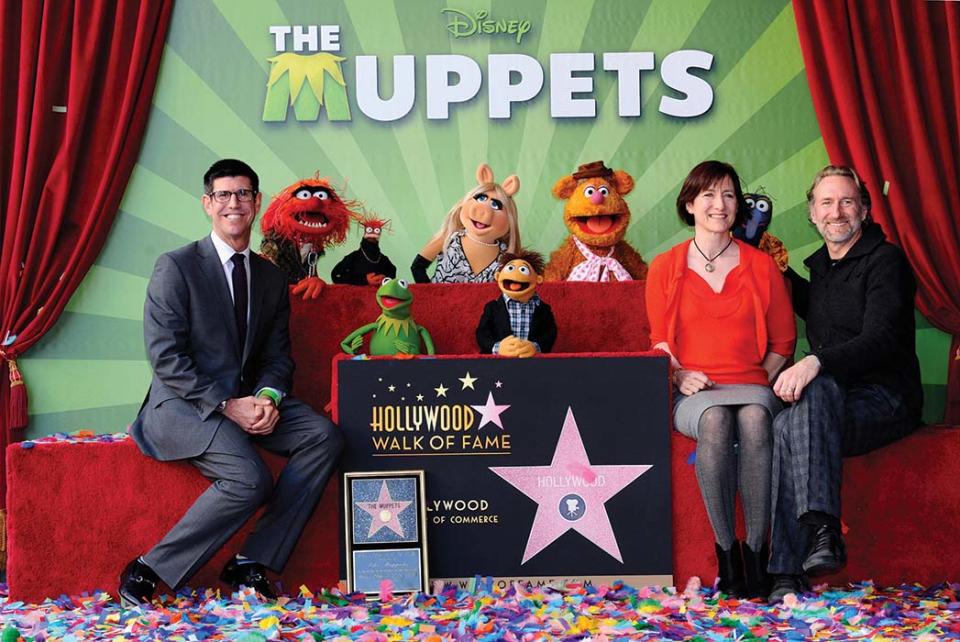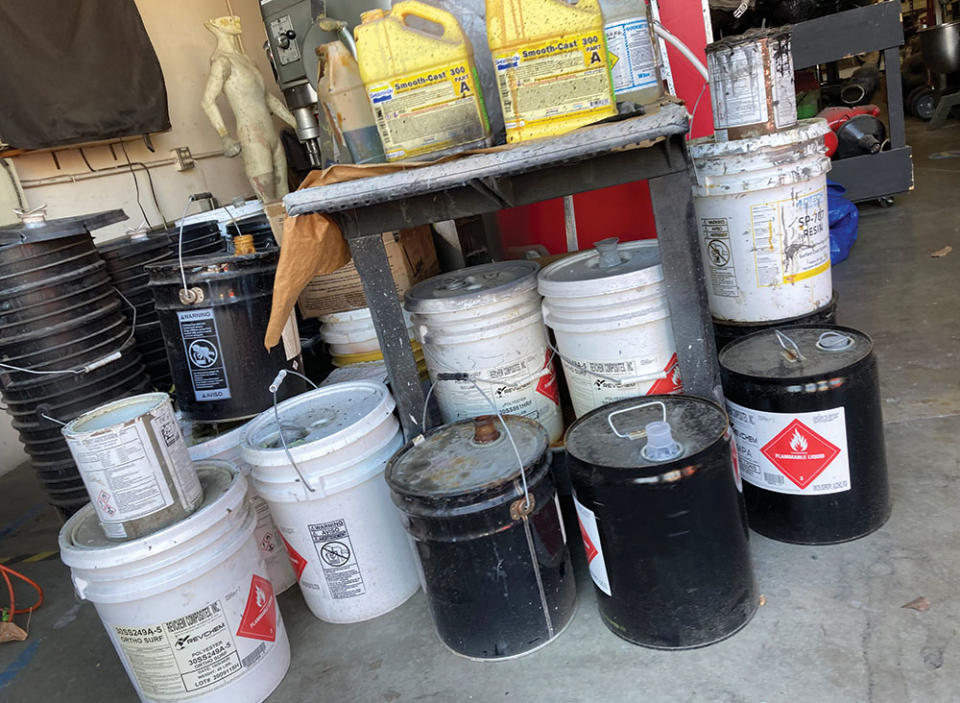Puppet Makers Rise Up Against the Puppet Masters
- Oops!Something went wrong.Please try again later.
- Oops!Something went wrong.Please try again later.
- Oops!Something went wrong.Please try again later.
- Oops!Something went wrong.Please try again later.

On his first day on set in November 2019, a puppet wrangler on Disney+’s Earth to Ned — a talk show spoof starring an alien puppet and produced by The Jim Henson Company — was told by another, more senior wrangler not to address one of the show’s star puppeteers, Kevin Clash, directly.
“Amongst other puppeteers, he’s known to be very bubbly and kind,” he recalls being warned of Clash. “But when it came to wranglers, I was told he tends to be condescending and nasty.”
More from The Hollywood Reporter
Film and TV Casting Directors Reach New Tentative Three-Year Contract Deal
Writers Guild's CBS News Union Ratifies New Three-Year Agreement
Puppet wrangling is an on-set position unique to Henson and Henson-adjacent companies like Sesame Workshop and the Muppets. It is a highly specific subspecialty that requires a varied set of skills, not the least of which is knowing how to build and repair puppets. There are only about 25 people in the world who work as full-time wranglers — and they are currently seeking union representation, something that has eluded them since the job first emerged with the rise of Sesame Street and The Muppet Show in the late 1970s.
A wrangler is a puppet builder who also works on set. “You’re the talent coordinator for a puppet, basically,” says Rachel Burson, a wrangler who has worked on shows like Comedy Central’s Crank Yankers (not a Henson production, but run by Victor Yerrid, a regular Henson puppeteer). Continues Burson, “You make sure the puppet’s in the right outfit, holding any props that they need to be holding and rigged to do any specialty moves. And then you are standing by a monitor while they’re filming, to make sure it looks good.”
Clash is best known for creating and voicing the iconic Sesame Street character Elmo. In 2012, four men filed civil lawsuits accusing Clash of having sex with them when they were minors — leading Clash, who denied the claims, to resign from Sesame Workshop “with a very heavy heart.” One of the accusers alleged that at age 16 he’d attended a 2004 crystal-meth-fueled sex party at Clash’s apartment in New York City. He filed his lawsuit in Pennsylvania; the three other accusers filed similar lawsuits, alleging similar activities, in New York. All the cases were later dismissed, the six-year statute of limitations on the allegations having expired.
Clash kept a low profile for several years, eventually resurfacing in Los Angeles, hometown of his friends Brian and Lisa Henson.
Brian and Lisa are heads of The Jim Henson Company, where they continue the innovative puppetry work pioneered by their father, the late Jim Henson. (The Jim Henson Company does not, however, work on arguably his most famous creation, the Muppets, stewardship of which transferred to Disney in 2004. Fabrication of Kermit, Miss Piggy, Fozzie and the rest is contracted to Puppet Heap, a New Jersey-based company founded by former Henson workers. Fabrication of Sesame Street’s characters including Big Bird, Cookie Monster and the Count still falls to The Jim Henson Company, which also manages its wrangling staff.)
Lisa and her brother put Clash to work on various Henson Company productions — first on the R-rated 2018 feature The Happytime Murders, then on the 2019 Netflix series The Dark Crystal: Age of Resistance and Disney+’s Earth to Ned in 2020. Most recently, he worked on Henson’s Fraggle Rock: Back to the Rock, the 2022 Apple TV+ reboot of the fantasy series.

An internal manual for 'Fraggle Rock' lists expectations of Henson wranglers.
It didn’t take long before the Ned wrangler found himself on the receiving end of Clash’s rumored temper, he says: “He yelled at me because he was leaving a voicemail as Elmo for someone’s kid. I think I was standing too close to him. He told me to ‘shut the fuck up.’ ” Clash did not respond by press time to a request for comment sent through the Henson Company.
Other puppet pros say the story did not sound like the Clash they knew. “My experience with Kevin is he is super generous, always showing newer performers how to puppeteer, happy to give you a laugh in the scene, and just super helpful,” says Joey Mazzarino, a Sesame Street puppeteer, writer and director.
Nevertheless, the wrangler says the dressing down by Clash was an indignity he was conditioned to accept. According to a dozen people consulted for this story — a mix of wranglers, builders and puppeteers (some of whom wear multiple hats) — the clubby world of puppeteering enables a wide array of workplace abuses against wranglers.
At the top of the puppetry ecosystem sit the puppeteers like Clash, who with the rise of Henson and the Muppets increasingly have emerged from the improv-comedy world. “Puppeteers flap their hands around and make funny voices and are told they are the talent,” says one frustrated Henson wrangler. “They know nothing about how the puppets work and could care less about them.” If a puppet breaks — which they frequently do from rough handling — “they toss them to us and tell us to fix it.”
Lack of unionization means wranglers have no access to guild-provided health care. (Henson has a small number on staff who get access to company plans, but the majority of its wranglers are freelance.) That’s a bitter pill to swallow for wranglers, who live in fear of suffering health consequences from prolonged exposure to toxic glues and chemicals used in puppet-making.
Says one production designer who works in the puppet world: “They’re always viewed as ‘lesser than,’ when they are just as qualified — actually far more skilled in the fabrication, engineering and manipulation of puppets — than the people being paid to perform.”
A letter from the Henson Company lawyers dismisses as “ridiculous” the “suggestion that the company considers wranglers to be ‘less than’ puppeteers. We have employed and continue to employ builders and wranglers who have literally been on our staff for decades, while puppeteers (with the exception of Brian Henson) are not on staff.”
But wranglers who spoke to THR describe a different world. As one industry veteran of over 40 years once told a wrangler newbie in a cafeteria line: “The job of the wrangler is eating shit and taking blame.”

Alberto E. Rodriguez/WireImage
***
A typical “fleece and foam” puppet, the kind generally associated with the Muppets, is 90 percent petrochemical materials, meaning they’re derived from the processing of petroleum and natural gas. This includes the foam and the fleece. But the glue is the most toxic element. The industry standard is a glue called Barge, containing toluene — which, if absorbed into the bloodstream through vapor inhalation or contact with the skin, can potentially lead to serious neurological problems, according to the Centers for Disease Control and Prevention and the Occupational Safety and Health Administration. Among such conditions is a disease called toluene-induced leukoencephalopathy, which can cause degradation of motor function and cognitive impairment. Barge with toluene is highly regulated by OSHA, which dictates that toluene must not exceed a concentration of 300 parts per million in any enclosed space — a difficult metric to measure and uphold. Barge makes a non-toluene version, which is easier to purchase, yet many builders prefer Barge with toluene because they find it to be more adhesive.
Horror stories regarding Barge and costume fabrication go back decades. A lawsuit filed by a performer in the 1998 Radio City Christmas Spectacular alleged that she suffered a stroke — resulting in brain damage and partial blindness — after inhaling Barge fumes while wearing an animal costume during a dress rehearsal. The litigation led to an undisclosed settlement with the defendants, who included the suit manufacturer, the makers of Barge and Radio City Productions. Industry watchdog publication ACTS: Arts and Theater Safety Newsletter called for the banning of Barge with toluene in 2003 — but the product is still dominant in puppetry. Barge did not respond to a request for comment.
It’s not the first dangerous solvent to be favored by the craft. “When I first started, I went to a school for puppetry being taught by a gentleman, Frank Ballard,” recalls Tim Lagasse, a puppeteer and builder who works with the Muppets and Helpsters, a Sesame Workshop-produced children’s show on Apple TV+. (Puppeteers can become builders and wranglers, but movement in the opposite direction is rare.)
“We were using these certain materials that were dangerous and we didn’t know,” Lagasse continues. “Then Frank retired because he got very sick. He got Parkinson’s disease.” Lagasse theorizes it was Ballard’s use of acetone — a popular solvent used to make marionettes in the 1960s and ’70s — that caused it. Ballard died in 2010 of Parkinson’s.
Illness and death have followed Lagasse throughout his career: “I had a friend of mine who died of cancer in his 40s — a puppet builder, pretty cavalier guy. They didn’t know what they were doing back in the day. Now, OSHA’s on top of all that kind of stuff.”
The last recorded visit by an OSHA inspector to the Henson Company’s Creature Shop facility in Burbank — based on an entry scribbled on an eyewash station seen in a photo shared with The Hollywood Reporter — was in 2017. OSHA’s online database contains no other mentions of inspections at any Henson facility, and calls to the agency were not returned.
As far as Henson is concerned, the company says it has broken no laws by using Barge with toluene. Henson “has not been presented with any facts suggesting any OSHA or other code violations in connection with the purchase or use of Barge,” the company replies in response to a query about its use of the adhesive. “Henson has not been the subject of claims by OSHA relating to Barge or otherwise. We are aware that our artists need to responsibly handle potentially toxic chemicals, including Barge, as part of their work, and follow appropriate safety protocols.”
To be sure, there is safety equipment available at Henson. “They do have fume hoods,” says Drew Massey, co-creator of Nickelodeon’s The Barbarian and the Troll. “It’s like a high-powered fan that sucks all the bad stuff up.”
But among lifetime builders, a culture of recklessness in handling toxic materials persists, sources say. “I know half the stuff we use is putting us all in an early grave,” says the production designer. Freelance Henson wranglers consulted for this story say they never attended safety training and that safety protocols at the company were left up to them.
***
According to Monona Rossol, a chemist, industrial hygienist and safety consultant to SAG-AFTRA, Henson is among the worst offenders when it comes to workplace safety. “They’re supposed to be doing safety seminars. Do they? Fuck no. Pardon my language,” says Rossol, who also runs ACTS. “It would take so little to take the necessary precautions, but they just don’t do it.” Wranglers tell THR that information about the dangers of working with Barge and other solvents usually comes by way of a more senior builder pulling a junior builder aside and warning them.
Photos of the Henson Creature Shop examined by THR reveal what one freelancer who took the pictures contends is a litany of workplace hazards. Industrial-size cans of Barge sit scattered throughout the workshop. Gallons of flammable polyester resin used in mold-making appear to be stored in damaged, leaking buckets. (The person who shot the photos says damaged containers are supposed to be disposed of to avoid the accidental mixing of chemicals.) Just a few feet away are breaker boxes and a tangle of electrical wires.

Buckets of flammable polyester resin in the Henson Creature Workshop, where wranglers claim working conditions are hazardous.
Asked by THR about Henson’s safety training and protocols, a lawyer for the company replies: “The Jim Henson Company and its businesses maintain rigorous safety standards and employ industry best practices, which it has been doing successfully for decades. Specifically, Jim Henson’s Creature Shop has an exemplary track record for quality, employee satisfaction and safety.”
Adding to their frustrations, multiple wranglers complain that builds for Henson shows like Fraggle Rock: Back to the Rock are chaotic, underfunded and short-staffed. Says one wrangler: “When I arrived at my last build job for Henson, they’d been working for one week on a job budgeted for two months, yet were insisting that the company was ‘out of money.’ It [raises] a really fundamental question: How and where is the money being spent? How can the company be ‘out of money’ if it hasn’t built anything?”
Wranglers who spoke to THR say many of their grievances could be addressed were they afforded the protections of a union. But even within the wrangling community, there is disagreement over which guild it should be.
“It’s hard for one group to want to claim us,” says Burson. “Because we do handle the costumes on the puppets. We do handle the props on the puppets. We do special effects. We have to put our foot in so many different departments. I think it just falls under the concept of tradition. ‘This is just always how it’s been.’ ”
Puppeteers were brought into the Screen Actors Guild in 1959 by then-SAG president Ronald Reagan, who was persuaded by Bob Baker, the marionette master who worked on films like Disney’s Bedknobs and Broomsticks, that puppeteers were performers. Back then, a puppet was generally something operated by rigging and string; it’s only since the rise of the Muppets that the dominant image of puppetry has morphed into felt-and-foam creations manipulated by voice actors.
According to Kevin Carlson, co-chair of the SAG-AFTRA National Puppeteers Committee, wranglers might belong in a union, just not his. “If they want to unionize, there’s a union for them: IATSE. It’s a craft union. It’s under costuming. I mean, it just seems so straightforward,” says Carlson, who runs a Facebook page for the roughly 150 SAG-AFTRA puppeteers.
Others in the industry — puppeteers and wranglers alike — agree that wranglers belong with IATSE’s props union, Local 44. But a faction of wranglers feel their specialty is not sufficiently defined by any existing technical guild. “Prop masters hire who they know and work with on set, so it would be a death knell for the wrangling specialty” to be folded into IATSE, says one wrangler. “Once the puppet is a prop, it can be handled by pretty much any on-set props person, which means they don’t have to track down a wrangler” for certain tasks that don’t require puppet-specific skills, he adds. “We’d just get replaced by props people and puppets would just become props. Even puppeteers don’t actually want that.”
Meanwhile, inclusion in the costumers’ guild, another IATSE local where rates are generally lower, could lead to a loss in income for more experienced wranglers. Occasionally, wranglers are called upon to help puppeteer on camera, which requires them to join SAG-AFTRA (a $4,000 entry fee plus annual dues); for those wranglers, joining an IATSE union would double their guild expenses.
Carlson is comfortable keeping wranglers out of SAG entirely, partly because he’s reluctant to further divide an already small pie. “I’m going to look at it from a selfish point of view,” he says. “When it comes to residuals, I’m a performer. Now the residual pool is getting shared even more so. That means less money to go around. I’m seeing the big picture, and our collective bargaining will be affected. We will have to give something up to get more people included.”
Several wranglers interviewed for this article counter that Carlson, as a puppeteer, is of course going to negotiate against their best interests. Especially because union jobs — with their contributions to health care and pensions — are a costly expense. Says Carlson, “Jim Henson was a lot more union-favorable. Brian is a little more testy about it. Brian is always looking for ways to save money.”
“Henson is not ‘anti-union,’ ” says a lawyer for The Jim Henson Company. “Neither is Brian Henson or Lisa Henson. Henson follows and respects all labor laws. The company does not tolerate abusive behavior. Wranglers and puppeteers both play important roles in Henson productions. The company respects the right of employees to unionize.”
This may be the moment for that to happen. Since 2021’s narrowly averted IATSE strike, crewpeople are more vigilant about union protections. “On every show I’ve worked on since last year, the props people have been very adamant in being, like, ‘Why aren’t you in the union?’ ” says Burson.
The next round of negotiations between the Alliance of Motion Picture and Television Producers and SAG-AFTRA — and the first since streaming has come to dominate the industry — is coming in 2023. A number of wranglers consulted for this piece are hopeful a vote by SAG-AFTRA puppeteers will see them join their ranks before those talks happen.
Some puppeteers are already on their side. “I don’t see any need to separate the skill sets,” says Barbarian and the Troll‘s Massey. “It’s often really handy to have people who perform actually know how things are built. I find things get broken less often if a performer has a sensitivity to how a puppet is constructed.”
As Tomas Seidita, lead wrangler on Showtime’s Kidding, puts it, “There will never be a better time to negotiate more for wranglers.”
March 17, 9 am PST Updated to clarify that Helpsters is produced by Sesame Workshop, not Jim Henson Co.
This story first appeared in the March 16 issue of The Hollywood Reporter magazine. Click here to subscribe.
Best of The Hollywood Reporter

